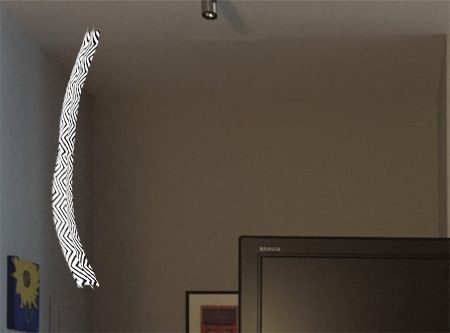After making a double latte one chilly morning, I hurried back under the covers to warm up and flipped on the TV. As I lay there watching the news and sipping my coffee I noticed a vivid, pulsating, black and white zig-zag pattern projected on the dark wall behind the TV. Fascination quickly turned to panic when I moved my head to look at it, and it moved with me! This light show was in my head and it was growing into a long arc on the left side of my field of vision. I closed my eyes to make it go away, but there it was, even more vivid against a black background. Was I having a stroke? A seizure? Did I have a brain tumor?

Somehow the phrase “classic zigzag pattern” bubbled up through my panic and I raced to the bookcase to find my copy of Oliver Sacks’ Migraine. Was this the classic zigzag pattern of a migraine, the elusive “aura” that I complained about never having experienced through a lifetime of debilitating migraines?
I nervously thumbed through the book until I found the section of renderings depicting visions similar to mine with the caption “A classical zigzag fortification pattern . . .” My relief was short-lived as I was, however, having great difficulty reading. This was the result, I later learned, of a blind spot that almost always accompanies the aura.
I tried to sound calm as I called Chaz who was out on a bike ride and described what was happening to me. By the time he had heroically rushed home, the hallucination was gone and I was beginning to regain my composure, confident now that I had experienced an aura. I waited to see if classic migraine symptoms – debilitating pain, nausea, sensitivity to light and sound – followed. They didn’t. I had finally had a painless migraine, and panic notwithstanding, I’ll take this new variety over the prolonged misery of a painful one any day.
It happened again a couple of weeks later. It started with a blindspot as I was trying to read something on my computer screen and quickly grew into an arc of pulsating, shifting, elongated triangles and zigzags, this time in technicolor, mostly oranges and blues, on the right side. I didn’t panic and was able to analyze and enjoy the show. At one point, Chaz, who just happened to be wearing a bright orange t-shirt, bent over to tie his shoe. The arc of his back lined up perfectly with my hallucination and it looked like orange and blue flames were shooting out of his back. I paced the floor (forget trying to do anything else) and observed the vision until it finally grew smaller and disappeared.
It’s been several months and I haven’t had another one.
Dr. Oliver Sacks, who the New York Times referred to as the “poet laureate of medicine,” wrote many books over the course of almost 50 years as a neurologist, researching and reporting on brain anomalies in accessible and entertaining prose. Among his works are The Man Who Mistook his Wife for a Hat, On the Move: A Life, an autobiography released shortly before his death last year, Hallucinations and my favorite, An Anthropologist on Mars: Seven Paradoxical Tales.
“The Case of the Colorblind Painter,” in Anthropologist is the story of a mature, accomplished artist, who after suffering a concussion in a car accident, becomes completely colorblind ― not your red/green-garden-variety colorblindness, but completely unable to see any color whatsoever. He struggles to recover in a black and white world.
“The Landscape of His Dreams” involves a man who becomes a painter after a strange illness. He is suddenly compelled to paint from memory every nook and cranny of his childhood home in Italy. It is as if he has a 3-D model of the town in front of him and can turn it to whatever perspective he wants. The obsession takes over and becomes his life.
These fascinating case histories go on and on in all of Sacks’ books, as he examines the abilities and disabilities of his patients with autism, mental illness, blindness, deafness, Tourette’s syndrome, savant syndrome, eidetic memory and more. Anyone interested in the workings of the human brain will find these anomalies a treasure trove of insight into its untapped potential.
I wish I could thank Sacks for diagnosing my painless migraine, for his compassion, and for the many hours of illuminating and entertaining reading he left behind.
